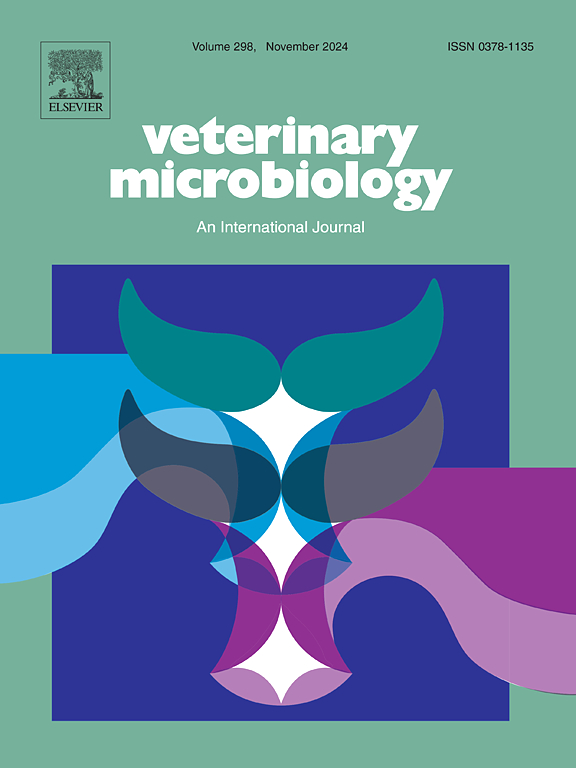Gleasserella parasuis autotransporter adp与主机交互波形蛋白促进细菌粘附和全身感染
IF 2.4
2区 农林科学
Q3 MICROBIOLOGY
引用次数: 0
摘要
Gleasserella parasuis是一个商业重要性病原体在上呼吸道的猪。它有能力侵入人体并在免疫功能低下的个体中引起全身感染。然而,副猪螺旋体蛋白与宿主分子在定植和入侵过程中的相互作用尚不清楚。在本研究中,我们通过共免疫沉淀和质谱分析确定了副猪螺旋体的自转运蛋白Apd与猪巨噬细胞的波形蛋白之间的相互作用。我们证实这种相互作用也发生在猪血清中。此外,Apd与vimentin的相互作用增强了副猪螺旋体在猪巨噬细胞中的粘附和侵袭。利用Δapd和野生型菌株进行的猪攻毒实验表明,Apd和vimentin的相互作用增加了副猪螺旋体的毒力和全身感染。因此,我们得出结论,Apd和vimentin之间的相互作用发生在不同的阶段,包括细菌粘附、入侵和感染。进一步研究Apd与vimentin的相互作用将有助于阐明副猪螺旋体感染、免疫和发病机制的分子机制。本文章由计算机程序翻译,如有差异,请以英文原文为准。
Gleasserella parasuis autotransporter Apd interacts with host vimentin to facilitate bacterial adhesion and systemic infection
Gleasserella parasuis is a commercial importance pathogen that colonizes the upper respiratory tract of pigs. It has the capacity to invade the body and cause systemic infections in immunocompromised individuals. However, the interactions between G. parasuis proteins and host molecules during colonization and invasion remain unclear. In the present study, we identified an interaction between the autotransporter Apd of G. parasuis and the vimentin protein in swine macrophages through co-immunoprecipitation and mass spectrometry analyses. We confirmed that this interaction also occurs in swine serum. Furthermore, the interaction of Apd with vimentin enhances the adhesion and invasion of G. parasuis in swine macrophages. A swine challenge experiment using Δapd and wild-type strains demonstrated that the interaction between Apd and vimentin increases the virulence and systemic infection of G. parasuis. Thus, we conclude that the interaction between Apd and vimentin takes place during various stages, including bacterial adhesion, invasion, and infection. Further investigation of the interaction between Apd and vimentin will contribute to elucidating the molecular mechanisms underlying infection, immunity, and pathogenesis of G. parasuis.
求助全文
通过发布文献求助,成功后即可免费获取论文全文。
去求助
来源期刊

Veterinary microbiology
农林科学-兽医学
CiteScore
5.90
自引率
6.10%
发文量
221
审稿时长
52 days
期刊介绍:
Veterinary Microbiology is concerned with microbial (bacterial, fungal, viral) diseases of domesticated vertebrate animals (livestock, companion animals, fur-bearing animals, game, poultry, fish) that supply food, other useful products or companionship. In addition, Microbial diseases of wild animals living in captivity, or as members of the feral fauna will also be considered if the infections are of interest because of their interrelation with humans (zoonoses) and/or domestic animals. Studies of antimicrobial resistance are also included, provided that the results represent a substantial advance in knowledge. Authors are strongly encouraged to read - prior to submission - the Editorials (''Scope or cope'' and ''Scope or cope II'') published previously in the journal. The Editors reserve the right to suggest submission to another journal for those papers which they feel would be more appropriate for consideration by that journal.
Original research papers of high quality and novelty on aspects of control, host response, molecular biology, pathogenesis, prevention, and treatment of microbial diseases of animals are published. Papers dealing primarily with immunology, epidemiology, molecular biology and antiviral or microbial agents will only be considered if they demonstrate a clear impact on a disease. Papers focusing solely on diagnostic techniques (such as another PCR protocol or ELISA) will not be published - focus should be on a microorganism and not on a particular technique. Papers only reporting microbial sequences, transcriptomics data, or proteomics data will not be considered unless the results represent a substantial advance in knowledge.
Drug trial papers will be considered if they have general application or significance. Papers on the identification of microorganisms will also be considered, but detailed taxonomic studies do not fall within the scope of the journal. Case reports will not be published, unless they have general application or contain novel aspects. Papers of geographically limited interest, which repeat what had been established elsewhere will not be considered. The readership of the journal is global.
 求助内容:
求助内容: 应助结果提醒方式:
应助结果提醒方式:


